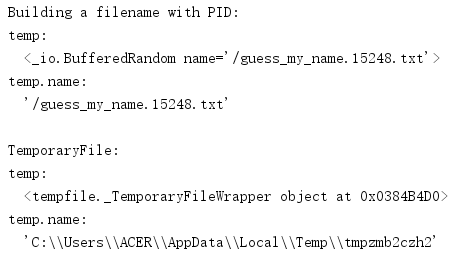1. tempfile临时文件系统对象
要想安全的创建名字唯一的临时文件,以防止被试图破坏应用或窃取数据的人猜出,这很有难度。tempfile模块提供了多个函数来安全的创建临时文件系统资源。TemporaryFile()打开并返回一个未命名的文件,NamedTemporaryFile()打开并返回一个命名文件,SpooledTemporaryFile在将内容写入磁盘之前先将其保存在内存中,TemporaryDirectory是一个上下文管理器,上下文关闭时会删除这个目录。
1.1 临时文件
如果应用需要临时文件来存储数据,而不需要与其他程序共享这些文件,则应当使用TemporaryFile()函数创建文件。这个函数会创建一个文件,而且如果平台支持,它会立即断开这个新文件的链接。这样一来,其他程序就不可能找到或打开这个文件,因为文件系统表中根本没有这个文件的引用。对于TemporaryFile()创建的文件,无论通过调用close()还是结合使用上下文管理器API和with语句,关闭文件时都会自动删除这个文件。
import os import tempfile print('Building a filename with PID:') filename = '/guess_my_name.{}.txt'.format(os.getpid()) with open(filename, 'w+b') as temp: print('temp:') print(' {!r}'.format(temp)) print('temp.name:') print(' {!r}'.format(temp.name)) # Clean up the temporary file yourself. os.remove(filename) print() print('TemporaryFile:') with tempfile.TemporaryFile() as temp: print('temp:') print(' {!r}'.format(temp)) print('temp.name:') print(' {!r}'.format(temp.name))
这个例子展示了采用不同方法创建临时文件的差别,一种做法是使用一个通用模式来构造临时文件的文件名,另一种做法是使用TemporaryFile()函数。TemporaryFile()返回的文件没有文件名。

默认的,文件句柄是使用模式'w+b'创建的,以便它在所有平台上都表现一致,并允许调用者读写这个文件。
import os import tempfile with tempfile.TemporaryFile() as temp: temp.write(b'Some data') temp.seek(0) print(temp.read())
写文件之后,必需使用seek()"回转"文件句柄以便从文件读回数据。

要以文本模式打开文件,创建文件时要设置mode为'w+t'。
import tempfile with tempfile.TemporaryFile(mode='w+t') as f: f.writelines(['first ', 'second ']) f.seek(0) for line in f: print(line.rstrip())
这个文件句柄将把数据处理为文本。

1.2 命名文件
有些情况下,可能非常需要一个命名的临时文件。对于跨多个进程甚至主机的应用来说,为文件命名是在应用不同部分之间传递文件的最简单的方法。NamedTemporaryFile()函数会创建一个文件,但不会断开它的链接,所以会保留它的文件名(用name属性访问)。
import os import pathlib import tempfile with tempfile.NamedTemporaryFile() as temp: print('temp:') print(' {!r}'.format(temp)) print('temp.name:') print(' {!r}'.format(temp.name)) f = pathlib.Path(temp.name) print('Exists after close:', f.exists())
句柄关闭后文件将被删除。

1.3 假脱机文件
如果临时文件中包含的数据相对较少,则使用SpooledTemporaryFile可能更高效,因为它使用一个io.BytesIO或io.stringIO缓冲区在内存中保存内容,直到数据达到一个阈值时,数据将“滚动”并写入磁盘,然后用常规的TemporaryFile()替换这个缓冲区。
import tempfile with tempfile.SpooledTemporaryFile(max_size=100, mode='w+t', encoding='utf-8') as temp: print('temp: {!r}'.format(temp)) for i in range(3): temp.write('This line is repeated over and over. ') print(temp._rolled, temp._file)
这个例子使用SpooledTemporaryFile的私有属性来确定何时滚动到磁盘。除非要调整缓冲区大小,否则很少需要检查这个状态。

要显示的将缓冲区写至磁盘,可以调用rollover()或fileno()方法。
import tempfile with tempfile.SpooledTemporaryFile(max_size=1000, mode='w+t', encoding='utf-8') as temp: print('temp: {!r}'.format(temp)) for i in range(3): temp.write('This line is repeated over and over. ') print(temp._rolled, temp._file) print('rolling over') temp.rollover() print(temp._rolled, temp._file)
在这个例子中,由于缓冲区非常大,远远大于实际的数据量,所以除非调用rollover(),否则不会在磁盘上创建任何文件。

1.4 临时目录
需要多个临时文件时,可能更方便的做法是用TemporaryDirectory创建一个临时目录,并打开该目录中的所有文件。
import pathlib import tempfile with tempfile.TemporaryDirectory() as directory_name: the_dir = pathlib.Path(directory_name) print(the_dir) a_file = the_dir / 'a_file.txt' a_file.write_text('This file is deleted.') print('Directory exists after?', the_dir.exists()) print('Contents after:', list(the_dir.glob('*')))
上下文管理器会生成目录名,可以在上下文块中用来建立其他文件名。

1.5 临时文件位置
如果没有使用dir参数指定明确的目标位置,则临时文件使用的路径会根据当前平台和设置而变化。tempfile模块包括两个函数来查询运行时使用的设置。
import tempfile print('gettempdir():', tempfile.gettempdir()) print('gettempprefix():', tempfile.gettempprefix())
gettempdir()返回包含所有临时文件的默认目录,gettempprefix()返回新文件和目录名和字符串前缀。


gettempdir()返回的值根据一个简单算法来设置,它会查找一个位置列表,寻找第一个允许当前进程创建文件的位置。
import tempfile tempfile.tempdir = '/I/changed/this/path' print('gettempdir():', tempfile.gettempdir())
如果程序需要对所有临时文件使用一个全局位置,但不使用以上任何环境变量,则应当直接设置tempfile.tempdir,为该变量赋一个值。
